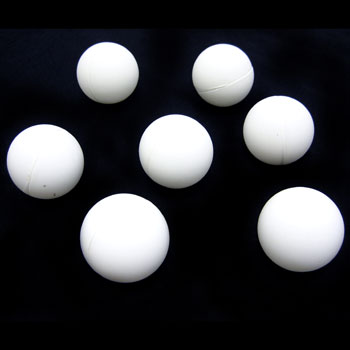Ping Pong Ball Blast-off!

When you drop a ball on the ground you probably expect it to bounce. If it's a really bouncy ball it might rebound almost back up to the height from which you dropped it (scientists would say that the collision with the floor is elastic, or the ball has a high coefficient of restitution). In this seemingly gravity defying experiment you will drop a ping pong ball to the ground (even in the grass if you like) and watch it blast back way over your head! How does it do that? To be honest we're not completely sure we understand exactly everything going on here- but it's sure cool!
What you'll need:
- A ping pong ball, any kind will do.
- An empty plastic yogurt or fruit cup (like the kinds shown below).
- Water- you'll probably want a bucket full so you can do this over and over again!
- A good place to to blast off, preferably outside or in your bath tub (if it has a flat bottom) because you will probably splash a lot of water. Asphault or concrete is fine, but, surprisingly, grass usually works just as well, and you'll be less likely to crack your cup from hitting a hard surface.
 
Basic Experimental Procedure:
- With your ping pong ball in your hand, hold your arm straight out from your body and drop it on the ground. How high does the ball bounce?
- Fill your cup about half full of water and float the ping pong ball in the cup.
- Hold the cup perfectly level with your hand over the top, hold your arm straight out again and drop the cup with the ball inside straight to the ground. You want the cup to remain level as it falls, without tipping over, and land flat on the ground. It may take a few tries to do this reliably.
- If all goes well and the cup lands flat on the ground, your ping pong ball should blast out of the cup very fast and shoot straight up in the air- 10 -15 feet if you're really lucky. You might also splash a bit of water- but that just makes it more fun!
- If it doesn't work, try again. Sometimes it takes a few tries to get a good blast. Make sure you are dropping the cup straight and level all the way to the ground.
- If you're still having trouble, the ball might be hitting the side of the cup on its way out. You may have noticed that when you put the ping pong ball in the water, the ball usually floats to the edge of the cup and stays there (try and make it stay in the middle- it's almost impossible!) Here's a trick to make it stay in the middle of the cup so that you can get a clean shot: fill the cup half full of water, then using a circular motion with your hand swirl the water in the cup (like a little tornado or whirlpool) for a few seconds before adding the ball. If you do this correctly, the ball should stay in the center of the cup and spin around. This happens because as you rotate the water it moves to the outside and starts to climb up the saides of the cup due to centrifugal force (many scientists prefer to call this the centripetal force of the cup puching on the water), just like when you make a turn too fast in your car and you slide towards the outside door. This causes the surface of the water to form a concave or bowl shape, and the ping pong ball simply falls down into the lowest height in the center. It also looks really cool, and this alone is a great science trick to show your friends. Now drop your cup and ball to the ground and hopefully you will get a better blast-off.
What's Happening:
When you release the cup, the ball, water and cup all fall together at the same speed, which increases as they fall (acceleration) due to the force of gravity. The cup hits the ground first, then the water slams into the bottom of the cup. As water molecules pile up they collide with each other and create a compression (squeeze) wave that travels upwards very fast. Keep in mind that at the instant this happens the ping pong ball is still falling downwards, because it started just a little higher. The water has much, much more mass than the ping pong ball, so when the upward moving wave collides with the downward moving ball a tremendous amount of energy and momentum is transferred to the ball. Because the ping pong ball has much, much less mass this transfer of momentum gives it a very high velocity upwards (due to conservation of momentum)- much more than the ball or water had even at the instant they hit the ground- blasting it much higher into the air than the height from which you dropped it. Amazing!
That's basically what's happening, but after a lot of experimenting and discussions with colleagues we think there may be a little more to this after all. Initially the ping pong ball floats on the surface of the water because of an upward force called buoyancy, which is in turn due to the pressure gradient in the water caused by its weight. In free-fall, however, the water (and everything else) is weightless, thus there is no pressure gradient to create any buoyant force on the ball. Does this mean that the ball sinks deeper into the water as it falls? What happens at the moment the water hits the ground and weight is restored (along with the extra force due to its downward velocity)? Does the surface tension of the water play any role, either during free-fall or at impact? Is a shock wave created in the water? If you have any thoughts, send an email to experiments@coolscience.org. or post a comment on our Youtube video.
Variations and Related Activities:
This is somewhat similar to what happens in another of our popular demonstrations. Hold a golf ball and a ping pong ball stacked vertically in your hand a few inches above a table or hard floor, with the golf ball on the bottom. Now carefully drop the two balls together so that they hit the table still stacked together. If you do this correctly, the ping pong ball will collide and bounce off the golf ball and shoot much higher in the air. [For our demonstration we drop the two balls in a tube.] There is also a popular toy based on this called the "Astro-Blaster" which has three or 4 rubber balls (with holes) stacked on a rod to hold them together.
Links to more information and activities
Bill Nye The Science Guy on Momentum:
More on Conservation of Momentum:
The Astro-Blaster science toy:
|